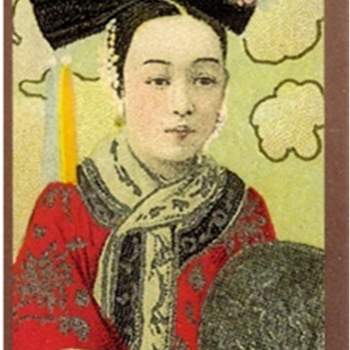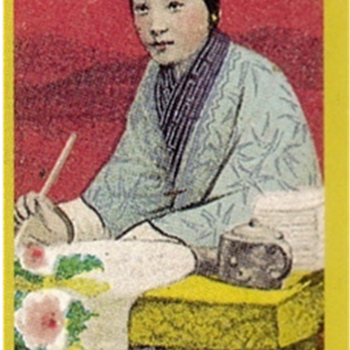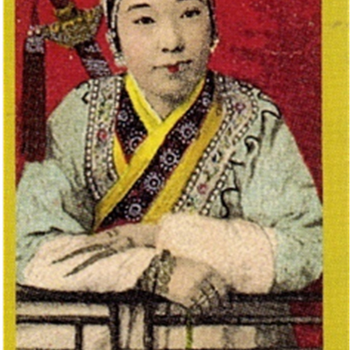The modern advertising industry can trace its roots to three interrelated developments in the late nineteenth century that had a massive impact on how people lived and worked: rising levels of urbanization, heavy industrialization, and new means of rapid short and long-haul transportation. It was a titan of American industry, Duke Tobacco Company[1], that brought cigarette cards to China during this era of globalization on the heels of the 1881 invention of a machine that cut and rolled uniform cigarettes, allowing for low-cost mass production. North Carolina tobacco baron James B. Duke (1865-1925) had never visited China, but he eyed cosmopolitan, internationalized Shanghai as an Asian test market in 1885 as part of a campaign to seize control over a lucrative foreign market. Duke salivated over the growth potential in China’s massive population and deployed some of his best agents to win the loyalty of local smokers.[2]
Duke’s initial advertising foray into China fell flat despite the success it had been enjoying back home for one very obvious reason: its early cigarette card designers knew nothing about the Chinese market and simply expected consumers there to react positively to the same sorts of images that worked in the United States. Given the heavily male tilt of China’s smokers, they assumed that risqué images of gorgeous western women would play as well as they did domestically.[3] As a result, they leaned in on a degree of overt sexuality, such as women in low cut dress revealing their bare legs and shoulders, that ultimately baffled male Chinese consumers who did not at all react in a universally-male manner to what they viewed as bizarrely-dressed light-skinned beauties. Had these designers tried to familiarize themselves with trends in Chinese visual art, they would have discovered a preference for much more subtle displays of sexuality and eroticism where women in full length, skin-concealing gowns were placed in certain poses or with floral arrangements and accompanying animals that hinted at more than immediately met the eye. The Americans made an easy correction when they hired Chinese artists who could better tap into local tastes and, by extension, boost sales of an imported product. In very short order, they were joined by Japanese and Chinese competitors that launched their own series of cigarette cards.[4]
The Japanese leader in cigarette production, the Murai Brothers Company,[5] was much more clever in its first venture into cigarette cards for the Chinese market. It went to several photo studios in Shanghai to buy the rights to existing pictures of Chinese women and used these as the basis for a set of white and black Qing Beauties cigarette cards that first circulated in late 1898.[6] In this early stage of China’s photography industry there was no expectation of copyright from scores of Chinese prostitutes, entertainers, and courtesans who came to be photographed and photographers felt no reservations about reusing their clients’ negatives for the studio’s own commercial benefit.[7] It became common practice for photographers to turn privately commissioned photos into both cigarette cards and the “photographically illustrated postcard,” a form of mass-produced photo print that enjoyed wide popularity from the early 20th century to World War I. These postcards also featured women prominently.
American penetration of Chinese tobacco market deepened following Washington’s “Open Door Note” to the great powers in 1899 declaring that it was official American policy that China should be able to trade with all countries on an equal footing. ATC sought to bring cigarette manufacturing directly to China (using American-grown tobacco), but it chose to respect foreign spheres of influence and locate its operations in open Shanghai. ATC’s first series of cigarette cards for Chinese consumers followed in 1900 soon after this new overseas enterprise launched. ATC’s Pinhead brand cigarettes released the first 25-card set of Qing Figures as a truly bi-national operation. Chinese artists were responsible for designs, which were then printed in New York and utltimately shipped back to Shanghai for packaging and sale.[8] ATC’s British competitors immediately followed with their own card series featuring Chinese women.
Chinese cigarette producers were at a severe disadvantage it terms of money and resources, but they nevertherless worked hard to demonstrate that they were not willing to simply roll over and hand their own domestic market over to foreign corporations.[9] The Qing government supported them financially through their “commercial war” (shangzhan商戰)[10] as a political imperative. The domestic cigarette industry launched in 1899 with the establishment of a handful of Chinese-funded producers including Great Elephant Tobacco Company in Beijing, the Fu Kou Tobacco Company in Yingkou, and the San Sin Cigarette Company in Shanghai. All three ultimately issued their own cigarette cards series,[11] but San Sin has the distinction of being the first Chinese producer to the market in 1904 with its set of 32 mono-colored cards with images of young women set against the backdrop of a Chinese room or a traditional garden from the late Qing dynasty.
Chinese producers borrowed the cigarette card medium for Americans, but their conservative designs of exclusively Chinese women wearing full-length late Qing era gowns could not have contrasted more with the overtly titillating style of the early Duke cards. These series featured Chinese women in immediately identifiable Chinese spaces, such as traditionally decorated rooms or gardens. The Han women in these cards featured wide foreheads, combed-back hair, and bound feet, also known as lotus feet. They wore serious visages from their debut through the World War I era, unlike the smiling beauties featured in western card series.[12] The war served as a major turning point, however, and what came after was a flood of radically new images showing Chinese women in modern dress pursuing opportunities that would have been unthinkable under the Qing.
[1] James Duke founded the American Tobacco Company (ATC) in 1890 as a consolidation with domestic industry leaders including Allen & Ginter and Goodwin & Company. The British-American Tobacco Company (BAT) followed in 1902 as ATC merged with its foreign archrival, the British Imperial Tobacco Company, after years of costly battle for control over international markets during the Great Tobacco War. See Howard Cox, The Global Cigarette: Origins and Evolution of British American Tobacco, 1880-1945 (Oxford: Oxford University Press, 2000). BAT was put under 2/3 American and 1/3 British control and this new arrangement created the biggest, most-recognized transnational cigarette corporation in the first half of the 20th Century.
[2] Sherman Cochran, Big business in China: Sino-foreign rivalry in the cigarette industry, 1890-1930 (Cambridge: Harvard University Press, 1980), 10-11.
[3] China most definitely did not abide by the same gendered conventions on smoking as found in the West. Empress Cixi favored Murai Brothers Company’s Peacock brand cigarette, which was successfully marketed to Chinese women and convinced many of them to take up the habit.
[4] Japan was the Asian leader in cigarette manufacturing and cigarette card production, gaining access to the Chinese export market as a result of new commercial privileges that resulted from its surprise victory in the First Sino-Japanese War in 1895.
[5] The Murai Brothers Company won control of the Japanese market thanks to the Japanese government’s protection and heavy foreign investment from ATC. It in turn funneled its huge profits into a substantial advertising campaign. See Sherman Cochran, Big Business in China, 40-42.
[6] Foreign and then later Chinese-owned photography studios flourished in China’s treaty ports from the 1870s. Shanghai was home to the best of them, which positioned the city well to later nuture the most sophisticated advertising operations in the country.
[7] Jonathan Hay, “Notes of Chinese Photography and Advertising in Late Nineteenth-Century Shanghai,” in Jason C. Kuo (ed.), Visual Culture in Shanghai, 1850s-1930s (Washington: New Academia, 2001), 103-04.
[8] Pu Chen (陈樸), Yang hua er (洋画儿 Cigarette cards) (Beijing: Renmin meishu chubanshe, 2006), 14.
[9] Not only did Chinese producers lack the resources to compete with BAT and more established Japanese brands, but they were also missing the social cachet of imports. BAT sold roughly two-thirds of all cigarettes in China as late as 1937, but Chinese companies had made inroads following major foreign boycott campaigns in 1905 and 1925. See Ellen Johnston Laing, Selling Happiness: Calendar Posters and Visual Culture in Early Twentieth-Century Shanghai (Honolulu: University of Hawaii Press, 2004), 29.
[10] Wennan Liu, ‘“No Smoking’ for the Nation: Anti-Cigarette Campaigns in Modern China, 1010-1935,” (Ph.D diss., University of California, Berkeley, 2009), 14-16.
[11] Chaonan Chen and Yiyou Feng, Old Advertisements and Popular Culture: Posters, Calendars, and cigarettes, 1900-1950 (San Francisco: Long River Press, 2004), 68.
[12] Ibid., 73.










